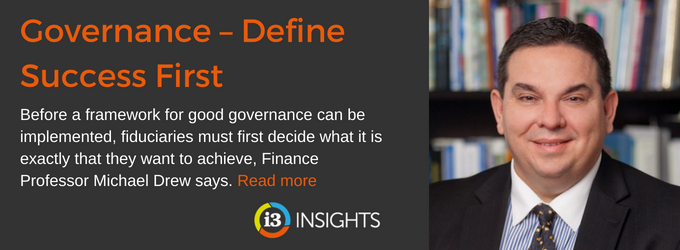Investment governance tries to codify how to put safeguards around managing other people’s money, Michael Drew and Adam Walk say in their new book.
Last year, we conducted a thought experiment with delegates at our Asset Allocation Forum to see how they dealt with decision-making under uncertain circumstances.
With the help of Professor Jack Gray, we laid out a hypothetical investment case where investors would be presented with a fund that produced remarkably high returns and had the blessing of some of the world’s most respected investment professionals, think of your personal heroes, who all had performed due diligence on it and given it the thumbs up.
The catch was that the delegates themselves would not be able to do due diligence on the fund and, therefore, would have little to no information about the strategy.
Would they invest their own money in it?
“Of course!” said over 70 per cent of delegates.
Then we changed the question: Now you are a fiduciary, would you invest your members’ money in it?
This time, 85 per cent of delegates said no.
It was the same investment case, but the answers to the two questions were diametrically opposed. So what was going on there?
Delegates argued the standards you put in place for managing other people’s money should be higher than you would if it was your own money at risk, and since there was no way to directly assess the opportunity, they felt they should walk away from it, regardless of how good the investment looked.
What was going on was the presented investment case failed the basic investment governance test.

I don’t think we are saying that boards and investment committees have to make all these decisions directly. Sometimes it might be better for them to delegate some of these decisions to others who are better placed to make those decisions. So yes, it is about organisational efficiency in part
Investment governance has gained increased attention in recent years and in 2012 the Australian Prudential Regulation Authority (APRA) issued guidance for pension funds on the subject through Prudential Standard SPS 530.
“SPS 530 requires an RSE (registrable superannuation entity) licensee to have in place a sound investment governance framework for the selection, management and monitoring of investments, including appropriate monitoring and management of investment risk, that is in the best interests of beneficiaries,” the prudential regulator states in its guidance paper.
But this definition applies only to pension funds, yet the characteristics of a particular institutional investor are crucial in determining appropriate investment processes and safeguards.
Two years ago, the CFA Institute Research Foundation asked Professors Michael Drew and Adam Walk, partners at Stonechat Capital, to take a broader look at investment governance and determine what elements are important for all fiduciaries.
The result of this exercise is the book Investment Governance for Fiduciaries, released earlier this year.
“The CFA Institute was approached to write a book on investment governance, both for fiduciaries of defined benefit and defined contribution plans, but also with a bit of a broader brief for family offices, endowments and charities. So it is a book about managing other people’s money, essentially,” Drew says in an interview with [i3] Insights.
Drew and Walk’s definition of investment governance is slightly broader than APRA’s in that it focuses not only on the investment and monitoring processes, but also extends to organisational efficiency and integrity.
“Investment governance refers to the effective use of resources – people, policies, processes, and systems – by an individual or governing body (the fiduciary or agent) seeking to fulfill a fiduciary duty to a principal (or beneficiary) in addressing an underlying investment challenge,” they write.
But essentially it comes down to a simple concept, Drew says. “Sometimes these conversations can fall down to compliance-based conversations, but for us it is not a question of ‘Are we doing things right?’ It is about a more holistic question around: ‘Are we doing the right things?’” he says.
“I don’t think we are saying that boards and investment committees have to make all these decisions directly. Sometimes it might be better for them to delegate some of these decisions to others who are better placed to make those decisions. So yes, it is about organisational efficiency in part.”
Investment governance is a framework for getting the best outcomes for the end beneficiary as you are taking responsibility for their wealth. In a pension setting, the end beneficiary can be quite removed from the investment process and a cynic might say that to get better outcomes for them it would be better to tackle the big issues, including agency risk, peer awareness and career risk.
Drew and Walk don’t deny these are important issues to solve, but are realistic about the impact individual organisations can have on these structural, industry-wide problems.
“We tried to design the process [in such a way] to minimise those things. But I don’t think we can eliminate it,” Drew laments.
But what organisations can do is ensure governance is given appropriate attention and not to reduce it to a simple box-ticking exercise.
“As we were writing the book, what became apparent to us was the need to appropriately resource the investment governance function for the complexity of the problem,” Walk says.

Too much governance time can be taken up by looking at manager-level returns
And the problem has become a lot more complex in the current market environment.
“We talk a lot in the industry about fees and costs, which we should do, but if you think back to the late 1980s, you could get a 7.5 per cent expected return really with a portfolio of just bonds and cash,” Walk says.
“Now, to get the same 7.5 per cent return 30 years later we have a combination of cash, credit, equity, smart beta and alternative assets. So a part of this conversation is sizing the investment governance architecture for the complexity of the problem that we are trying to solve.
“We use the metaphor of a resourcing envelope to achieve the required resourcing to ensure there is risk assurance and alignment in getting portfolio outcomes.
“In the book, we provide a framework that looks at translating time-weighted returns into more outcomes-based, money-weighted returns, looking even at the post-retirement phase and the probability of shortfalls, so that the fiduciaries spend the bulk of their governance time on an outcome-orientated frame.
“Too much governance time can be taken up by looking at manager-level returns.”
Investment Governance for Fiduciaries
By Michael E. Drew and Adam N. Walk
192 pp. CFA Institute Research Foundation Books. 2019
Link to PDF (Free)
For a general guide on ESG issues in Australia, please see here.
__________
[i3] Insights is the official educational bulletin of the Investment Innovation Institute [i3]. It covers major trends and innovations in institutional investing, providing independent and thought-provoking content about pension funds, insurance companies and sovereign wealth funds across the globe.



